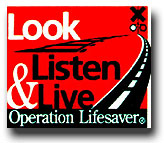
Operation Lifesaver ®

Operation Lifesaver ®
Operation Lifesaver is a national, non-profit public education program dedicated to ending collisions, deaths and injuries at highway-rail grade crossings and along railroad rights-of-way.
This page provides highway-rail facts, driving tips and and Track Facts and Tips from Operation Lifesaver. After visiting this page we encourage you to visit Operation Lifesaver's Web Site.

Final 2000 Highway-Rail Facts
- In 2000, at least 425 people were killed and 1,219 seriously injured in 3,502 highway-rail grade crossing collisions (combinded for public and private crossings). (Source: Federal Railroad Administration)
- At least 463 people were killed and 414 were injured while trespassing on railroad rights-of-way and property.(Source: Federal Railroad Administration)
- Approximately every two hours either a vehicle or a pedestrian is struck by a train in the United States. That's 12 incidnets each day!
- A motorist is 40 times more likely to die in a crash involving a train than in a collision involving another motor vehicle
- There are approximately 255,000 public, private and pedestrian at-grade highway-rail crossings in the United States
- More people die in highway-rail grade crossings crashes in teh United States each year than in all commercial and general aviation crashes combined
- Nearly 50 percent of vehicle/train collisions occur at crossings with active warning devices (gates, lights, bells).
- Most crashes occur within 25 miles of the motorist's home.
- Trains cannot stop quickly:
- Average freight train stopping distance:
55 mph = over 1 mile.
Eight-car passenger train stopping distance:
79 mph = over 1 mile.
- The majority of highway-rail crashes occur when the train is traveling slower thn 30 mph.
- Railroad tracks, trestles, yards and equipment are private property. Walking or playing on them is illegal--trespassers are subject to arrest and fines. Too often the penalty is death.


Operation Lifesaver Driving Tips
- Never drive around lowered gates--it's illegal and deadly. If you suspect a signal is malfunctioning, call the 1-800 number posted on or near the crossing signal or you local law enforcement agency.
- Never race a train to the crossing--even if you tie, you lose.
- Do not get trapped on the tracks. Only proceed through a highway-rail grade crossing if you are sure you can completely clear the crossing without stopping. Remember, the train is trhee feet wider than the tracks on both sides.
- If your vehicle stalls on a crossing, immediately get everyone out and far away from the tracks. Call you local law enforcement agency for assistance. Look for a 1-800 emergency notification number nearby to contact the railroad.
- At a multiple track crossing waiting for a train to pass, watch out for a second train on the other tracks, approaching in either direction.
- ALWAYS EXPECT A TRAIN! Freight trains do not follow set schedules.
- Be aware that trains cannot stop quickly. Even if the locomotive engineer sees you, a freight train moving at 55 miles per hour can take a mile or more to stop once the emergency brakes are applied. That's 18 football fields.
- Do not be fooled by the optical illusion--the train you see is closer and faster moving than you think. If you see a train approaching, wait for it to go by before you proceed across the tracks.


Track Facts & Tips
- Railroad tracks, trestles, yard and equipment are private property. Walking or playing on them is illegal--trespassers are subject to arrest and fines. Too often the penalty is death.
- There are 200,000miles of railroad tracks in the United States.
- Since 1990, more than 5,500 people have been killed while trespassing on railroad rights-of-way and property.
- Trains cannot stop quickly. A freight train moving at 55 miles per hour, or an 8-car passenger train moving at 79 miles per hour, can take a mile or more to stop.
- Do not walk, run, cycle or operate all terrain vehciles (ATVs) on railroad tracks or rights-of-way or through tunnels.
- Cross tracks only at designated pedestrian or roadway crossings. Observe and obey all warning signs and signals.
- Do not hunt, fish or bungee jump from railroad trestles. They are not designed to be sidewalks or pedestrian bridges--there is only enough clearance on the tracks for a train to pass.
- Do not attempt to hop aboard railroad equipment at any time. A slip of the foot can cost you a limb, or your life.
- ALWAYS EXPECT A TRAIN! Freight trains do not follow set schedules.
- Remember: Rails and recreation do not mix.

|

